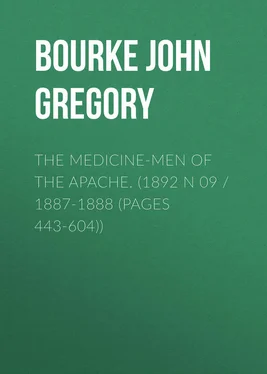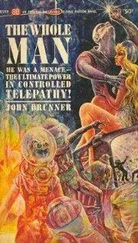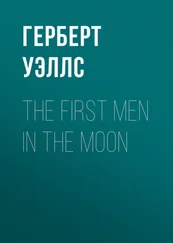John Bourke - The Medicine-Men of the Apache. (1892 N 09 / 1887-1888 (pages 443-604))
Здесь есть возможность читать онлайн «John Bourke - The Medicine-Men of the Apache. (1892 N 09 / 1887-1888 (pages 443-604))» — ознакомительный отрывок электронной книги совершенно бесплатно, а после прочтения отрывка купить полную версию. В некоторых случаях можно слушать аудио, скачать через торрент в формате fb2 и присутствует краткое содержание. Жанр: foreign_antique, foreign_prose, на английском языке. Описание произведения, (предисловие) а так же отзывы посетителей доступны на портале библиотеки ЛибКат.
- Название:The Medicine-Men of the Apache. (1892 N 09 / 1887-1888 (pages 443-604))
- Автор:
- Жанр:
- Год:неизвестен
- ISBN:нет данных
- Рейтинг книги:4 / 5. Голосов: 1
-
Избранное:Добавить в избранное
- Отзывы:
-
Ваша оценка:
- 80
- 1
- 2
- 3
- 4
- 5
The Medicine-Men of the Apache. (1892 N 09 / 1887-1888 (pages 443-604)): краткое содержание, описание и аннотация
Предлагаем к чтению аннотацию, описание, краткое содержание или предисловие (зависит от того, что написал сам автор книги «The Medicine-Men of the Apache. (1892 N 09 / 1887-1888 (pages 443-604))»). Если вы не нашли необходимую информацию о книге — напишите в комментариях, мы постараемся отыскать её.
The Medicine-Men of the Apache. (1892 N 09 / 1887-1888 (pages 443-604)) — читать онлайн ознакомительный отрывок
Ниже представлен текст книги, разбитый по страницам. Система сохранения места последней прочитанной страницы, позволяет с удобством читать онлайн бесплатно книгу «The Medicine-Men of the Apache. (1892 N 09 / 1887-1888 (pages 443-604))», без необходимости каждый раз заново искать на чём Вы остановились. Поставьте закладку, и сможете в любой момент перейти на страницу, на которой закончили чтение.
Интервал:
Закладка:
The second necklace, consisting of four fingers, was buried, as Gen. Crook did not wish to have kept more than one specimen, and that only for scientific purposes. Accordingly, the necklace here depicted was sent first to the U. S. Military Academy at West Point, New York, and later to the National Museum in Washington, where it was believed it could better fulfill its mission of educating students in a knowledge of the manners and customs of our aborigines.
The buckskin bag, with the papooses' hands, was claimed by the Shoshoni scouts, who danced and wailed all night, and then burned the fearful evidence of the loss sustained by their people.
The necklace is made of a round collar of buckskin, incrusted with the small blue and white beads purchased from the traders, these being arranged in alternate spaces of an inch or more in length. There are also attached numbers of the perforated wampum shell beads of native manufacture. Pendant from this collar are five medicine arrows, the exact nature of which, it was, of course, impossible to determine from the owner himself. Both Frank and Baptiste agreed that an arrow might become "medicine" either from having been shot into the person of the owner himself or into the body of an enemy, or even from having been picked up under peculiar circumstances. The owner, High Wolf or Tall Wolf, admitted as much after he had surrendered at the Red Cloud Agency and had made every effort to obtain the return of his medicine, which was this necklace.
The four medicine bags to be seen in the picture are worthy of attention. They were carefully examined under a powerful glass by Dr. H. C. Yarrow, U. S. Army, in the city of Washington, and pronounced to be human scrota. The first of these contained a vegetable powder, somewhat decomposed, having a resemblance to hoddentin; the second was filled with killikinnick; the third with small garnet-colored seeds like the chia in use among the Apache, and the fourth with a yellow, clayey-white vegetable matter not identified. The fifth, also, remained unidentified.
Besides the above, there are artificial teeth, resembling those of the fossil animals abundant in the Bad Lands of South Dakota, but cut out of soft stone.
The fingers – eight altogether – are the left-hand middle fingers of Indians of hostile tribes, killed by High Wolf. I obtained the list and could insert it here were it worthwhile to do so. The fingers have not been left in the natural state, but have been subjected to very careful and elaborate antiseptic treatment in order thoroughly to desiccate them. They were split longitudinally on the inner side and after the bone had been extracted the surface of the skin, both inside and out, received a treatment with a wash or paint of ocherous earth, the same as is used for the face. I was told that the bones were not replaced but that sticks were inserted to maintain the fingers in proper shape.
Of the reason for making use of such a trophy or relic, there is not much to be said; even the savages know little and say less. From the best information that I have been able to gather, it would seem to be based partly upon a vainglorious desire to display the proofs of personal prowess, and partly upon the vague and ill defined, but deeply rooted, belief in the talismanic or "medicinal" potency possessed by all parts of the human body, especially after death. It was such a belief which impelled the Mandan, Aztecs, and others of the American tribes to preserve the skulls of their dead as well as (among the Aztecs) those of the victims sacrificed in honor of their gods. As has been shown in another place, the Zuñi and others take care to offer food at stated periods to the scalps of their enemies.
The use of necklaces of human fingers or of human teeth is to be found in many parts of the world, and besides the fingers themselves, we find the whole arm, or in other cases only the nails. The Cheyenne did not always restrict themselves to fingers; they generally made use of the whole hand, or the arm of the slaughtered enemy. In a colored picture drawn and painted by one of themselves I have a representation of a scalp dance, in which the squaws may be seen dressed in their best, carrying the arms of enemies elevated on high poles and lances. There is no doubt in my mind that this custom of the Cheyenne of cutting off the arm or hand gave rise to their name in the sign language of the "Slashers," or "Wrist Cutters," much as the corresponding tribal peculiarity of the Dakota occasioned their name of the "Coupe Gorge" or "Throat Cutters."
The necklace of human fingers is found among other tribes. A necklace of four human fingers was seen by the members of the Lewis and Clarke expedition among the Shoshoni at the headwaters of the Columbia, in the early years of the present century. Early in the spring of 1858 Henry Youle Hind refers to the allies of the Ojibwa on Red River as having "two fingers severed from the hands of the unfortunate Sioux." 130 130 Assinniboine and Saskatchewan Expedition, vol. 2, p. 123.
In Eastman's "Legends of the Sioux," we read of "Harpsthinah, one of the Sioux women, who wore as long as she could endure it, a necklace made of the hands and feet of Chippewah children." 131 131 New York, 1819, pp. x, xxix, 47.
We read that in New Zealand, "Several rows of human teeth, drawn on a thread, hung on their breasts." 132 132 Forster, Voyage Round the World, vol. 1, pp. 219, 519.
Capt. Cook speaks of seeing fifteen human jaw bones attached to a semicircular board at the end of a long house on the island of Tahiti. "They appeared to be fresh, and there was not one of them that wanted a single tooth;" 133 133 Hawkesworth, op. cit., vol. 2, p. 161.
and also, "the model of a canoe, about three feet long, to which were tied eight human jaw bones; we had already learnt that these were trophies of war." 134 134 Ibid., p. 257.
Capt. Byron, R. N., saw in the Society Islands, in 1765, a chief who "had a string of human teeth about his waist, which was probably a trophy of his military prowess." 135 135 Ibid., vol. 1, p. 113.
"The wild Andamanese, who live only on the fruits of their forests and on fish, so far revere their progenitors that they adorn their women and children with necklaces and such like, formed out of the finger and toe-nails of their ancestors." 136 136 Forlong, Rivers of Life, vol. 1, pp. 541, 542.
Bancroft says 137 137 Nat. Races, vol. 1, p. 380.
that the Californians did not generally scalp, but they did cut off and keep the arms and legs of a slain enemy or, rather, the hands and feet and head. They also had the habit of plucking out and preserving the eyes.
Kohl assures us that he has been informed that the Ojibwa will frequently cut fingers, arms, and limbs from their enemies and preserve these ghastly relics for use in their dances. Sometimes the warriors will become so excited that they will break off and swallow a finger. 138 138 Kohl, Kitchi-gami, pp. 345, 346.
Tanner says of the Ojibwa: "Sometimes they use sacks of human skin to contain their medicines, and they fancy that something is thus added to their efficacy." 139 139 Tanner's Narrative, p. 372.
Of the savages of Virginia we read: "Mais d'autres portent pour plus glorieuse parure une main seiche de quelqu'un de leurs ennemis." 140 140 John de Laet, lib. 3, cap. 18, p. 90, quoting Capt. John Smith.
Of the Algonkin we read: "Il y en a qui ont une partie du bras et la main de quelque Hiroquois qu'ils ont tué; cela est si bien vuidée que les ongles restent toutes entieres." 141 141 Le Jeune in Jesuit Relations, 1633, vol. 1, Quebec, 1858.
The Mohawk "place their foe against a tree or stake and first tear all the nails from his fingers and run them on a string, which they wear the same as we do gold chains. It is considered to the honor of any chief who has vanquished or overcome his enemies if he bite off or cut off some of their members, as whole fingers." 142 142 Third Voyage of David Peter De Vries to New Amsterdam, in Trans. N. Y. Hist. Soc., vol. 3, p. 91.
Интервал:
Закладка:
Похожие книги на «The Medicine-Men of the Apache. (1892 N 09 / 1887-1888 (pages 443-604))»
Представляем Вашему вниманию похожие книги на «The Medicine-Men of the Apache. (1892 N 09 / 1887-1888 (pages 443-604))» списком для выбора. Мы отобрали схожую по названию и смыслу литературу в надежде предоставить читателям больше вариантов отыскать новые, интересные, ещё непрочитанные произведения.
Обсуждение, отзывы о книге «The Medicine-Men of the Apache. (1892 N 09 / 1887-1888 (pages 443-604))» и просто собственные мнения читателей. Оставьте ваши комментарии, напишите, что Вы думаете о произведении, его смысле или главных героях. Укажите что конкретно понравилось, а что нет, и почему Вы так считаете.












